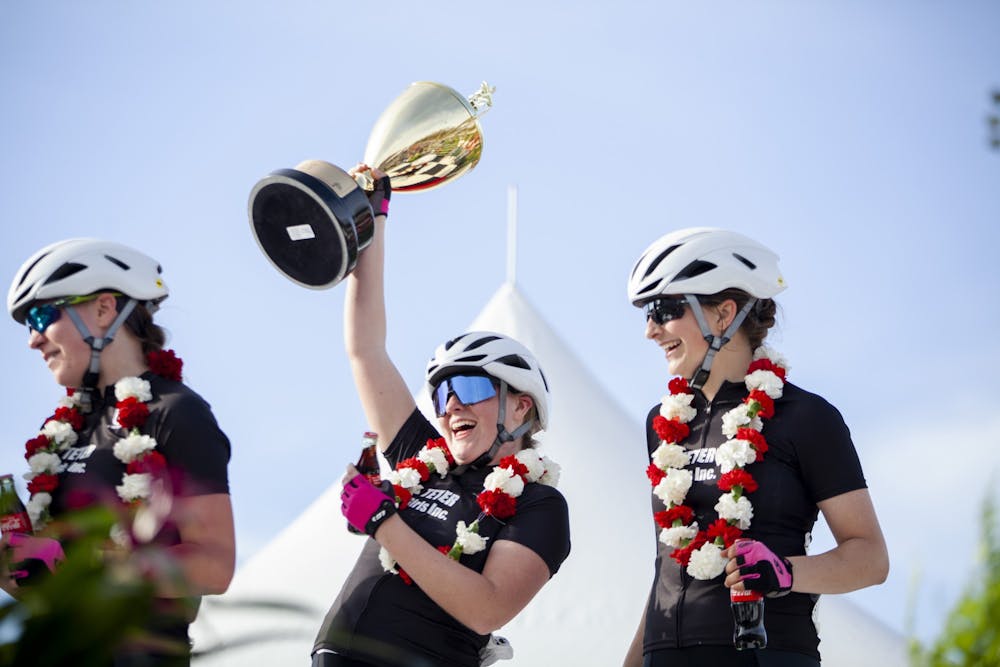“The World's Greatest College Weekend” is back.
In 2020, the race was canceled due to the COVID-19 pandemic. In 2021, the race was held without fans in May instead of its usual April race date. This year, the race is back — and so are all the festivities that go along with it.
For the seniors who haven’t experienced a Little 500 weekend in three years, and for all the other students who have never experienced one, here’s a history of the race and everything else you need to know.
IU Foundation Executive Director Howdy Wilcox, Jr started the Little 500 in 1951. Wilcox saw students holding informal bike races around dorms and decided to model a bike race after the Indianapolis 500, a race his father won in 1919.
In 1987, four Kappa Alpha Theta sorority members tried to qualify for the Little 500. On their third qualifying attempt, they finished the run and qualified 34th — one position short of making the field. In response, the inaugural women’s race ran in 1988.
Both races feature up to 33 teams — there are 22 in the women’s race this year — and teams are made up of up to four undergraduate amateur riders, who complete up to 10 exchanges for the men and five for the women throughout the race.
The races have been held at Bill Armstrong Stadium’s cinder track every year since 1981 and are put on by the IU Student Foundation. Money raised from the Little 500 goes into an IU Student Foundation scholarship fund that has handed out more than $2 million to undergrads, according to the Little 500 website.
Kappa Alpha Theta will start in first for the 34th women’s race, which lasts 100 laps. The race takes place at 4 p.m. Friday, April 22.
Phi Kappa Psi will sit on the pole for the 71st running of the 200-lap men’s race, which begins at 2 p.m. Saturday, April 23.
KEY TERMS
Bike: Each team receives two bikes from the IU Student Foundation for race day. The Schwinn bikes are a single speed, coaster brake, 700c wheeled bike and are not allowed to have any modifications.
Exchange: Teams have to switch riders 10 times during the men’s race and five times during the women’s race. Teams can exchange riders using one bike or a full-bike exchange using two bikes.
Pole: The team that starts the race in first place.
Pits: Selected in order of qualification, each team will have their own pit to set up in. When completing an exchange, the rider getting off the bike must stop by the end of the next pit or receive a penalty.
Flags: There are seven flags used throughout the race: green, yellow, red, white, checkered, black (ride on outside of the track) and blue with an orange stripe (bicycle attempting to pass).
Pack: A group of riders together, usually including the teams near the lead.
Draft: A rider will line up behind another biker, reducing air resistance and allowing the rider to draft — putting in less effort to maintain a speed.
Sprinter: A team’s fastest rider in short bursts, who will often be tasked with the last lap or two in order to finish the race.
Burn: In preparation for an exchange, the current rider will sprint to separate from the pack before they exchange, “burning” their remaining energy.
Marking: When a team begins a burn, a second team will mark them to pressure them into an exchange, to prevent the burning team from faking and creating a lead.
Set: A period of laps a rider spends on the bike before exchanging. Riders with more stamina may ride longer sets, while sprinters will ride shorter and faster sets.
Lapped traffic: Once a team is off the lead lap, they will be directed to the outside of the track as the pack passes them to avoid interfering with the leaders.
Yellow jersey: The winning team from the year before wears a yellow jersey on race day. Last year’s winners were Jetblach for the men’s and Delta Gamma for the women’s.
Spring Series: A series of four events in the weeks leading up to the race that involve all the riders, including Qualifications, Individual Time Trials, Miss-N-Out and Team Pursuit. The overall winning team of the Spring Series gets to wear a white bike jersey on race day.
Qualifications: Also known as Quals, a team gets four laps to set a fastest time and qualify within the 33-man Little 500 field. The fastest team qualifies on the pole and receives a green jersey to wear on race day.
Individual Time Trials: ITTs are also a four-lap event, but are completed individually. Four riders compete at the same time, starting in each corner of the track, to complete four laps first.
Miss N Out: Starting in heats of five to eight, the last place rider is eliminated every lap until three riders remain. The three advance to the next round until the final heat of eight. Once three riders are left on the last heat, they begin a one-lap sprint to determine the winner.
Team Pursuit: Two teams of four start on opposite ends of the track and chase each other down in a pace line for 15 laps. The teams are timed based on the third rider to cross the finish line. The two fastest teams compete to determine the winner.
“Breaking Away”: The 1979 movie about the Little 500 won an Academy Award for best original screenplay. The race team Cutters, who won in 2018 and 2019 and has the most wins in the men’s race with 14, was named after the movie.




